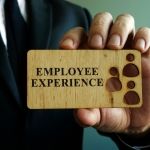Can you name the year Mike Rutherford and his band, Mike + The Mechanics, began their hit song “Living Years” by telling us, “Every generation blames the one before, and all of their frustrations come beating on your door”? Anyone identifying as a Generation Xer or a second wave baby boomer will recall this 1988 hit, which contains strong themes of poor communication and regrets over missed opportunities. Similar scenarios play out in the workplace when trying to manage five generations of workers. The topic now becomes whether your organization can see the warning signs and if you are poised to respond with the right actions.
The most multi-generational workforce in history currently exists. Most studies show that millennials/Generation Yers make up about half the current workforce. Generation Xers are roughly 25 percent of the workforce, with Gen Zers and baby boomers evenly splitting the other 25 percent. Parents of the boomers are sometimes called the silent generation or traditionalists. While they make up an increasingly smaller sliver, they are still counted as part of the workforce.
Contrary to what some believe, the presence of five generations in the workforce is not a problem, it is an opportunity. Generational diversity within the workforce has the potential to lead to better problem solving, a stronger ability to future-proof your business, and a more stimulating and enriching environment for top talent. As with any great business opportunity, some organizations will be quick to A Multi-Generational Workforce Is a Force for Good identify the upside and act deliberately to leverage the opportunity, while others act more slowly or not at all.
Before considering action plans for turning this opportunity into a competitive advantage, companies are advised to look introspectively to understand what it looks like for all five generations to co-exist within the eco-system of their organization. Consider these three intersecting challenges.
Challenge 1
An aging workforce is set to walk out the door with a tremendous amount of institutional knowledge, information, and skills.
What this looks like in the workplace:
According to Bruce Tulgan and his 2022 edition of The Great Generational Shift (Rainmakingthinking.com), 42 percent of the current workforce was born before 1978. To break this down further, more than two in five workers have reached their mid-40s, and one in five are aged 58 or older. With the growing popularity of semi-retirement, and early retirement, every organization runs an increased risk of knowledge walking out the door. To compound the problem, these departures are coming with increasingly shorter notice. The most respected and tenured employees work until age 65 less regularly.
Challenge 2
Younger generations expect growth and development to be a standard part of employee value propositions. When this expectation is not met, these generations do not hesitate to change companies.
What this looks like in the workplace:
Gen Yers and the emerging Gen Zers expect continuous growth and learning in all aspects of life. Organizations that do not structurally support their hunger for continuous learning risk losing them to companies that do.
Challenge 3
Work-related preferences for each generation are more prominent than they have ever been.
What this looks like in the workplace:
While the idea that different generations have varying work styles is not new, it becomes more prominent when generations show up to work side-by-side every day. The two most prominent differences between Gen Xers and baby boomers, and Gen Zers and millennials, lie in the areas of information exchange and communication.
- Information Processing: Older generations prefer to gather and categorize information. Younger generations are comfortable filtering information and leveraging it as needed.
- Communication Style: Older generations prefer formal communication through defined channels. Younger generations are more comfortable with constant communication, utilizing high tech, and relying on high contact communication methods (virtual is fine but face-to-face interaction is preferred) for valuable information.
Before launching any new programs, it is advised to articulate and share the reason behind the focused effort. This particularly applies when asking people with distinctly different preferences in communication styles to work together. Asking people to be more deliberate in the way they connect with each other may require initiating a sensitive conversation.
Here are some suggestions to help ensure success:
- Make sure your succession planning is up to date. Identify high potential employees as successors to key positions currently occupied by older-generation employees. Create paired partnerships, or mentor-mentee relationships, specific to how that key position fits into and drives the organization on a larger level. This doesn’t change the current job of the high potential worker, but it does provide an opportunity for learning and growth in preparation for advancement within the company. The new relationship also helps provide a sense of value for both the mentor and mentee.
- Ask older-generation workers to develop and lead knowledge sharing sessions, aka lunch-and-learn sessions. Consider inviting as many younger generation workers as you can accommodate, allowing them to opt into the conversation. Again, both younger and older generation employees find value in this type of opportunity.
- If you don’t already have employee-focused internal publications, consider adding one. Older generation/experienced employees can share knowledge in their own words as a mentoring tool. The younger generation may need encouragement to read the information, but they can also be paired with a mentor to review it in person or discuss expanded ideas.
The song “Living Years,” reinforces the concept of taking advantage of the time available to address unresolved issues. Recognize the strengths and preferences that are present in each generation of your workforce and move forward to develop and implement knowledge transfer solutions.
For more information on how to begin the knowledge transfer process within your organization, contact Pete Petersen, Organization Development Director, at 262.696.3668 or [email protected].





